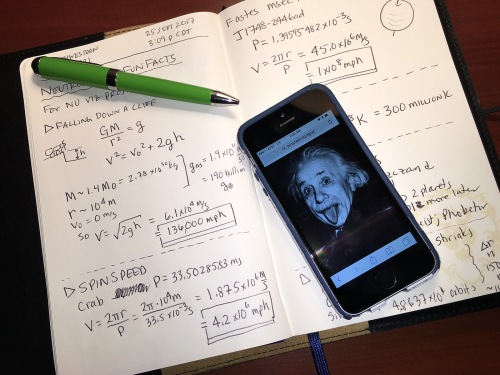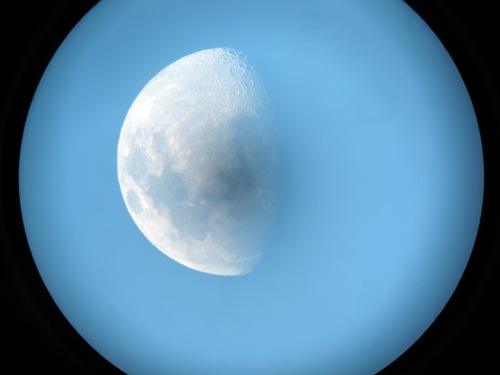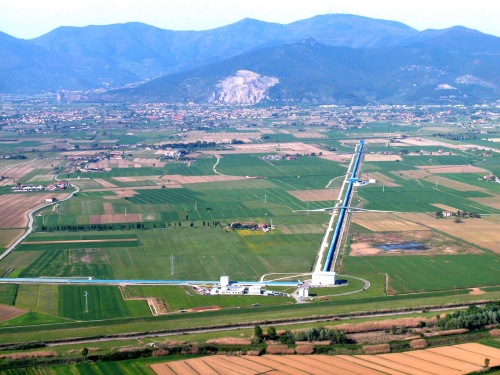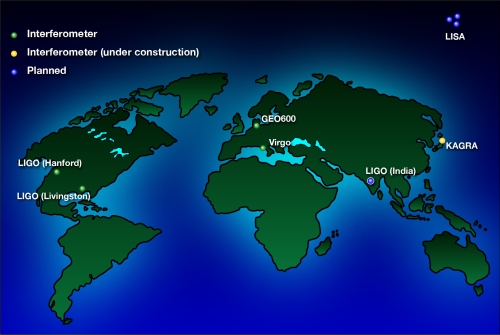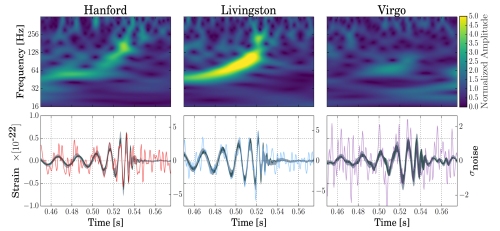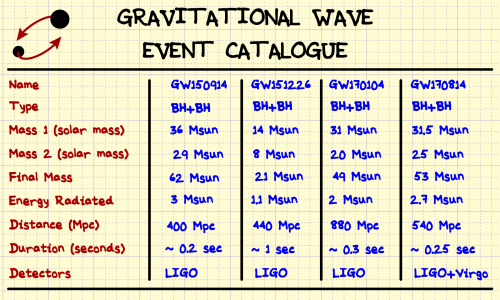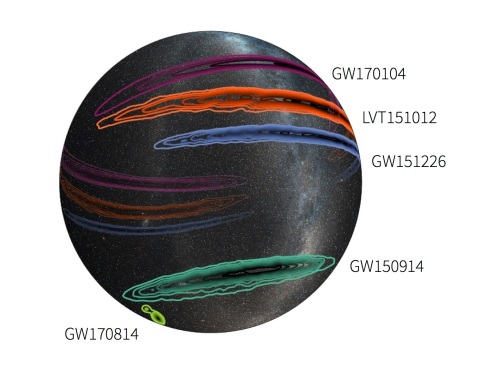by Shane L. Larson

The Cosmos wheels above our heads, far out of reach but well within our powers of perception. Always we wonder, what’s happening now and what does it mean? [Image: S. Larson]

[L to R] Hubble Space Telescope, the ATLAS detector at the Large Hadron Collider, and LIGO-Livingston. Exquisite technology expands our ability to observe the Universe around us.
Big discoveries emerge almost immediately, because the Universe is always up to something, and always up to something that is dramatic and stunning to behold. If you build an exquisite experiment, you’re going to discover something. Such was the case of Hubble’s discovery of the existence of other galaxies, when we constructed the 100-inch Hooker Telescope on Mount Wilson. Such was the case of Rosalind Franklin’s discovery of double-helix structure of DNA with the development of x-ray crystallography. Such was the case of the discovery of the Higgs Boson with the construction of the Large Hadron Collider. Such was the case with LIGO and Virgo, which over the past three years have witnessed six different gravitational wave events.

My personal accounting of every known gravitational wave event, accurate and complete up through GW170817. When we announced GW170608, my page was too narrow to include it!
Today, the LIGO-Virgo Scientific Collaboration announced our first catalog of gravitational wave events — GWTC-1 (Gravitational Wave Transient Catalog). It is the current complete list of every event we’ve discovered in our data. Some of them you know about, because we have talked about them before (even here on this blog: GW150914, GW151226, GW170104, GW170814, GW170817). But since then, we’ve been sifting through the data, looking at every feature, comparing it to our astrophysical predictions, cross-checking it against monitors that tell us the health of the instruments, determining if it appears in all the detectors, and using our most robust (but slow-running) super-computer analysis codes.
The result is the catalog before you (if you’re curious, you can see the catalog at the Gravitational-wave Open Science Center), that has improved values for the properties of all the previously announced sources, and four new binary black hole sources that were in the data: GW170729, GW170809, GW170818, and GW170823. Additionally a source previously known as LVT151012 (“LIGO-Virgo Trigger“) has been renamed GW151012.

A screen cap of GWTC-1, the first “Gravitational Wave Transient Catalog of Compact Binary Mergers” as it appeared today. The number of events, the amount of data about what the Cosmos is doing, is growing. [Image: LIGO-Virgo Collaboration]
But today when you look at the long list of events it strikes me, for the first time, that this is a huge and ever-growing collection. We’ve always known that would be the case, but there is something viscerally pleasing about watching it happen right before your eyes. It is clear that the list is now long enough that it would be challenging to memorize!

We don’t have images of the gravitational wave events, but our artists can imagine what the members of our collection might have looked like at the moment we observed them. [Images: Aurore Simonnet/LIGO-Virgo Collaboration/Sonoma State University]
This is absolutely the case in astronomy — sometimes we have many observations, sometimes we have only a few, but we always want more. Having many observations is paramount to understanding the Cosmos because observations are the only things we have. We are confined to observing the Universe from this small world on which we live, and what we know is built completely on our few, meager observations.
What stands out the most in the new LIGO catalog? We are still letting the implications settle in, but the most important thing the new events do is it makes our estimate of the popuatlion of black holes in the Universe more accurate, and we’ve started to examine those implications is a new study that is being released in tandem with this announcement. But let me highlight the things that personally catch my attention the most.

This shows all the known masses of black holes and neutron stars, detected both by traditional telescopes and using gravitational waves. I’ve highlighted the new black holes in the catalog in green. You can explore this plot with an interactive we’ve created at CIERA. [Image: LIGO-Virgo/Frank Elavsky/Northwestern]
Second, it is interesting to look at the black holes that merged and consider how they are different from one another. From the existent data, it looks like the black holes that merge are always close to the same mass. So far, we’ve never seen a smaller black hole fall into another black hole that is five or ten times larger. Does that mean it never happens in Nature? Or does it mean it happens rarely? Or does it mean we’re not good at seeing or recognizing such events yet? The answer is an important one because the sizes of the black holes before they merge tells us something about how they form and grow together. That question is of intense interest to astronomers since black hole formation is tied to stellar evolution, and stellar evolution is tied to how all the stuff around us is made.
Lastly, the trend continues to show that LIGO and Virgo are sensitive to heavier black holes than those that have been previously known from traditional telescopes. The dramatic demonstration that there are stellar-origin black holes near 100-solar masses is stimulating dramatic conversations among astronomers (particularly theoretical astronomers like my group, who study stellar evolution) about how the Cosmos creates these large black holes.

Left to Right: LIGO-Hanford (Hanford, Washington), LIGO-Livingston (Livingston, Louisiana), and Virgo (Pisa, Italy). All three detectors are currently working toward the start of our new observing run (“O3”) in the Spring of 2019. When new data begins to flow, the catalog is going to start growing once again.
Perhaps the most exciting thing to me, is this is just the beginning. LIGO and Virgo are currently in a maintenance phase, but our third observing run (“O3”) will begin in the spring of 2019. The instruments will be performing at higher precision than ever before, and there are going to be more detections that will make this catalog grow even larger. Our questions are swirling, the anticipation is palpable. But even more importantly, there is a dedicated group of scientists, particularly those who work in signal analysis, computer science, and machine learning, who are developing new and improved techniques for finding signals in data. There are great practical applications to such endeavours (like how do you separate the 25 zillion text messages sent by teenagers every five minutes), but it will once again help grow our gravitational wave catalog, expanding our understanding of the stellar graveyard of the Universe.
Once new data is being collected, the data from our previous observing runs will sit there in the open data archives, waiting for someone to come back and look at it again. Historically, there have always been discoveries made in archived astronomical data long after it was collected. Data is simply too complex to understand everything in it, and we are simply too naive about everything that is going on in the Universe to recognize everything in our data the first time we work with it. There is certainly more in the LIGO-Virgo data than even this catalog. But progress is slow, and only the future will show us what is yet to be discovered, in an every growing tree of knowledge, dividing and growing from our previous discoveries.

Examples of Lichtenberg figures, created by electrical discharges and discovered by the father of experimental physics, Georg Christoph LIchtenberg. Knowledge, like these figures, branch and grow continuously from each other. [Images: Wikimedia Commons]
So today, please join us in basking in the glow of new discovery, reveling in the joy that this is just the beginning, and there is no end. Congratulations to my colleagues and friends in LIGO and Virgo; we’ll do this again sometime soon!
Several of my colleagues in LIGO and Virgo have also written about the new catalog — please check out their posts as well!
- Christopher Berry — The O2 Catalogue – It goes up to 11
- Mark Hannam — Digging in the Stellar Graveyard

